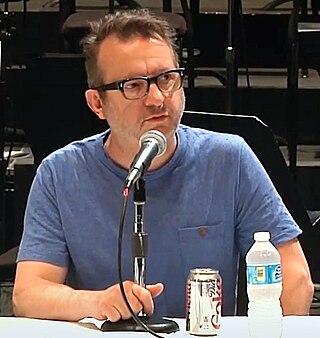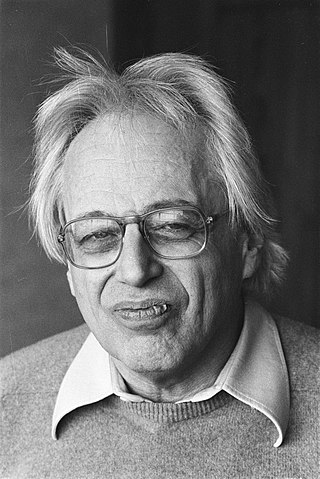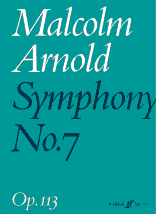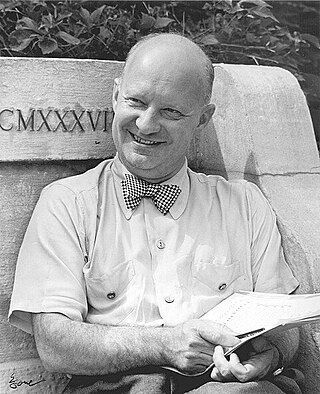Related Research Articles

Mark-Anthony Turnage is an English composer of contemporary classical music.
Polish composer Witold Lutosławski's Concerto for Orchestra was written in the years 1950–54, on the initiative of the artistic director of the Warsaw Philharmonic, Witold Rowicki, to whom it is dedicated. It is written in three movements, lasts about 30 minutes, and constitutes the last stage and a crowning achievement of the folkloristic style in Lutosławski's work. That style, inspired by the music of the Kurpie region, went back in time to the pre-1939 years. Having written a series of small folkloristic pieces for various instruments and their combinations, Lutosławski decided to use his experience of stylisation of Polish folklore in a bigger work. However, the Concerto for Orchestra differs from Lutosławski's earlier folkloristic pieces not only in that it is more extended, but also in that what is retained from folklore is only melodic themes. The composer moulds them into a different reality, lending them new harmony, adding atonal counterpoints, and turning them into neo-baroque forms.

Ulf Håkan Hardenberger is a Swedish trumpeter, conductor, and professor at the Malmö Academy of Music.

The Concerto for Violin and Orchestra by György Ligeti is a violin concerto written for and dedicated to the violinist Saschko Gawriloff. A performance of the work lasts about 28 minutes.

The Symphony No. 7, Op. 113 by Malcolm Arnold was finished in 1973. It is in three movements:
Huw Thomas Watkins is a British composer and pianist. Born in South Wales, he studied piano and composition at Chetham's School of Music in Manchester, where he received piano lessons from Peter Lawson. He then went on to read music at King's College, Cambridge, where he studied composition with Robin Holloway and Alexander Goehr, and completed an MMus in composition at the Royal College of Music, where he studied with Julian Anderson. Huw Watkins was awarded the Constant and Kit Lambert Junior Fellowship at the Royal College of Music, where he used to teach composition. He is currently Honorary Research Fellow at the Royal College of Music.

The trumpet repertoire consists of solo literature and orchestral or, more commonly, band parts written for the trumpet. Tracings its origins to 1500 BC, the trumpet is a musical instrument with the highest register in the brass family.

Twice Through the Heart is a musical work by the English composer Mark-Anthony Turnage, variously described as a dramatic scena, as a monodrama, as a song cycle, as a chamber opera or even as a "dramatic song-cycle-cum-scena". It is scored for mezzo-soprano and 16 instrumentalists and sets an English-language libretto by the Scottish poet Jackie Kay based on her script for a television programme about a woman jailed for killing her violent husband.
Greek is an opera in two acts composed by Mark-Anthony Turnage to a libretto adapted by Turnage and Jonathan Moore from Steven Berkoff's 1980 verse play Greek. The play and the opera are a re-telling of Sophocles's Greek tragedy Oedipus Rex with the setting changed to the East End of London in the 1980s. The opera was first performed on 17 June 1988 in the Carl-Orff-Saal of the Gasteig, Munich, in a co-production by the Munich Biennale, the Edinburgh International Festival and the BBC.

The conductor Malcolm Sargent's career as a recording artist began in the days of acoustic recording, shortly before the introduction of the microphone and electrical recording, and continued into the stereo LP era. He recorded prolifically from 1924 until 1967, the year of his death.
The English conductor Sir Adrian Boult was a prolific recording artist. Unlike many musicians, he felt at home in the recording studio and actually preferred working without an audience. His recording career ran from November 1920, when working with Diaghilev's Ballets Russes he recorded the ballet music, The Good-Humoured Ladies, to December 1978, when he made his final recording of music by Hubert Parry.
L'Arbre des songes is a violin concerto written by Henri Dutilleux between 1983 and 1985. It is dedicated to Isaac Stern.
The Partita for Harpsichord and Orchestra, sometimes also referred to as Partita for Harpsichord, Electric Guitar, Bass Guitar, Harp, Double Bass, and Chamber Orchestra or Harpsichord Concerto, is a composition by Polish composer Krzysztof Penderecki. It was finished in 1971 and is Penderecki's only major composition for a harpsichord soloist.
The Percussion Concerto No. 2 is a concerto for solo percussion and orchestra by the Scottish composer James MacMillan. The work was jointly commissioned by the Netherlands Radio Philharmonic, the Philharmonia Orchestra, the Orchestre national du Capitole de Toulouse, the Cabrillo Festival of Contemporary Music, the Baltimore Symphony Orchestra, and the São Paulo State Symphony. It was first performed on November 7, 2014 at TivoliVredenburg in Utrecht, the Netherlands, by percussionist Colin Currie and the Netherlands Radio Philharmonic under conductor James Gaffigan. The composition is MacMillan's second percussion concerto after 1992's Veni, Veni, Emmanuel.

Die Harmonie der Welt Symphony, IPH 50, is a symphony by German composer Paul Hindemith composed in 1951, which served as the basis for his opera Die Harmonie der Welt.
Night Dances is one of the first compositions for orchestra written by British composer Mark-Anthony Turnage. It was written in 1981 and was awarded the Guinness Prize for composition that year.
Your Rockaby is a concerto for soprano saxophone and orchestra written by the British composer Mark-Anthony Turnage. It was completed in 1993.

Blood on the Floor is a suite in nine movements composed for orchestra and jazz trio by Mark-Anthony Turnage. It was composed over a span of three years (1993–1996) after a commission from the Ensemble Modern—a German music group—to produce a piece for an evening jazz event in 1994. After the performance, Turnage expanded the piece into a larger nine-movement suite. During this period of composition, Turnage's brother Andrew died of a drug overdose, shaping the music greatly. As a result, drug culture is one of the main themes in the suite. Blood on the Floor also draws influences from the paintings of Francis Bacon and Heather Betts; the suite's title is an adaptation of Bacon's painting Blood on Pavement.

Towards Paradise (Labyrinth VI) is a trumpet concerto by German composer Jörg Widmann. It was composed in 2021 and premiered on 23 September 2021 by soloist Håkan Hardenberger and the Gewandhausorchester Leipzig conducted by Andris Nelsons at Gewandhaus.

Jörg Widmann's Horn Concerto was composed in 2023–24 and premiered on 30 May 2024 with soloist Stefan Dohr and the Berlin Philharmonic under the direction of Simon Rattle at Berliner Philharmonie. The work has enigmatic as well as humorous elements.
References
- 1 2 Turnage, Mark-Anthony (1996). Dispelling the fears: after a painting by Heather Betts : for two trumpets and orchestra (1994-95) (in Chinese). London: Schott. Retrieved 5 July 2020.
- ↑ "Blood on the Floor". englisch. Retrieved 5 July 2020.
- ↑ Guides, Rough (2010). The Rough Guide to Classical Music. Rough Guides UK. p. 589. ISBN 978-1-84836-677-0.
- ↑ Simeone, Nigel (2015). Liner notes of Decca 478 8356. Baarn: Decca.
- ↑ "Mark-Anthony Turnage: Your Rockaby; Night Dances; Dispelling the Fears - Various Artists | Songs, Reviews, Credits | AllMusic". AllMusic . Retrieved 5 July 2020.
- ↑ "Turnage: Blood on the Floor - Peter Erskine, Martin Robertson, John Scofield, Peter Rundel | Songs, Reviews, Credits | AllMusic". AllMusic . Retrieved 5 July 2020.